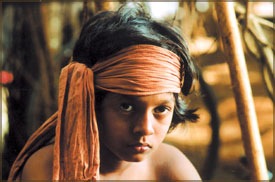|
DAILY NEWS ONLINE |
|
|
|
OTHER EDITIONS |
|
|
|
OTHER LINKS |
  |
|
Film review Samanala Thatu provokes social consciousnessSamanala Thatu presents quite a different aspect of life from the usual Sinhala film. There is not much in cinematic narrative, but it relates the plight of street children effectively. There is much about children of whom society is unaware of; even the so-called child protection officials and the police. There are various categories of children, different in their behaviour and activities according to the background they live.
The children in the film are totally innocent and their parents are leading an honest living. The child protection officials raise their questions, with high and mighty authority. Why are the children not sent to school? The reasons are obvious. From their point of view the child should go into probation custody. The child finds it lonely and he is homesick. He needs his mother and (deformed) sister. This is the most important point in the film. This child living under a Banyan tree in a city is not aware of his full name or date of birth. Leave alone a postal address a requirement of the probation and police officials. These conditions are due to the social and political matters and also the depleted economy. In Switzerland or Germany the situations are almost not to be found. The new rich enjoy the day with their families, however, this aspect has not been well integrated in the film. These isolated incidents are only used as a contrast. The narrative construction is weak and the scenes used are insufficient to support it. They are more or less blocks carrying bits of information. These sequences fail to take the viewer to an emotional peak. Normally, we believe the street boys are corrupted; here the boy is too innocent to protect himself. The boy is obsessed with having a beautiful red bicycle. It is expressed effectively by the director. The climax of the film is a rare thoughtful moment where a child is accepting the reality of the world. The moment he takes the maroon waistband with frills to his hands the whole world changes. This deserves credit for the director for his cinematically presented closing shot. The film indirectly causes the affluent and the rich to realize the painful reality of the other side of the same society. The various fascinating sweets and other food items, clothes and toys seen on television and shopping malls serve only to a tiny fraction of society. Not only street children, even other children a little better off than they see them only as a fantasy. This point has been raised as a concealed layer in the film. The cinematography unconsciously travels away from the theme and the in-depth meaning of the film. In general, it has a colourful brilliance that is seen in common films. The little boy does more performance than the father according to the script. The things he does appears too much for himself (which of course is the reality of the outside world). However, this activity amounts to exposition of child labour, to which the film is against. We see total innocence in this child and he carries the entire film with his very expressive performance. Most of the little things he does appear to come out of his own, which is much more than popularly known film acting. The expression seen when he decides to take up his father's profession is something noteworthy. The filmed version of street children has been given a sophisticated look; a cross section of life of such children is much more rough and unpleasant. Newspapers give shocking stories of these children. Samanala Thatu appears to have been painted in a lighter tone. Even the lighting adds a lot of glamour to the boy. More values than entertainment are found in the film. A meaningful attempt creating awareness, in a line of 24 films exhibited during a year, very rarely one would find a film of this nature. The largest number of Sinhala films is on common themes flooded with songs, dancing girls and villains. There are also themes handling detective stories, war background and simple romances. Whatever it may be they are ineffective, showing incapable handling. In this background Samanala Thatu is much ahead of the average Sinhala film. We find the glamorous film stars missing and the commanding heroes and villains dissolved in the air; yet, the film has the power to capture the viewer and hold him to the end. The bitterness that rises at the end is twisted to hope and survival, driving away the clouds of depression about to cover their lives as the little boy takes a crucial decision to support his family. Samanala Thatu is an unusual Sinhala film; in its many aspects of a non-commercial venture. It provokes a certain social consciousness. It shows how a little child loses his childhood innocence and his world of expectations due to no fault of his. What have we really done for him and the others like him? .................................. |
|
|
|

